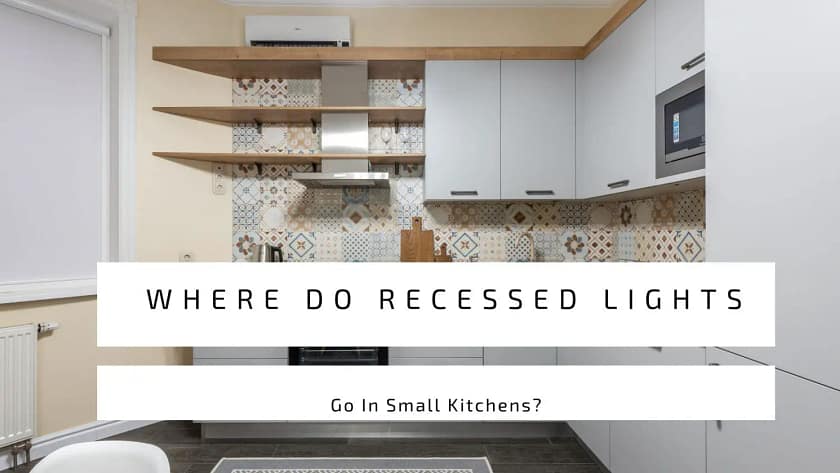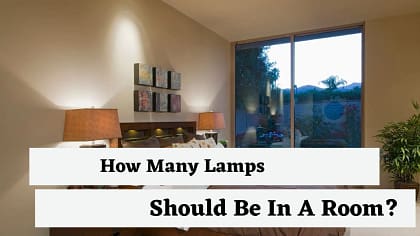A small kitchen is challenging to light, especially if there isn’t good natural lighting. While pendant lights are an excellent choice, recessed lighting can provide great illumination.
Small kitchens benefit from recessed lighting because these lights do not take up as much space as hanging fixtures. Recessed lights provide general illumination for the kitchen and are perfect for task and under-cabinet lighting.
You can install recessed lights in drywall or plaster ceiling at specific focal points, such as the kitchen sink or range top. Adding a dimmer switch can also control the amount of light in the room. This allows you to increase the brightness when cooking or soften it when relaxing.
How to Lay Out Recessed Lighting In Small Kitchens?
When spacing out recessed lighting, divide the height of the ceiling by two. The answer will give you an accurate amount of space to leave between each fixture.
For instance, for an 8 feet ceiling, the spacing should be 4.
If you have a ceiling fan in the kitchen, you can use this to help determine where the lights should be placed. Lights should be placed no closer than 4 feet from the side of the fan because this will greatly reduce its effectiveness.
The same is true with recessed lighting. Lights that are too close to each other will make it difficult for anyone to see what they are doing.
Recessed lights come in different sizes, colors, and trim styles. The most common size is 6 inches. A 4-inch recessed light works well in small areas where there is limited space between the bottom of the cabinet and the ceiling.
How Many Recessed Lights Do I Need In A Small Kitchen?
When installing recessed lights, it is important to consider how many you will need. The answer depends on the size of the room and the light’s purpose.
For example, if you plan on using them solely for task lighting purposes, such as over a kitchen sink or countertop, you’ll need fewer recessed lighting than if you wanted them to be the primary light source for a room.
Four to six evenly spaced lights are usually sufficient in a small kitchen; however, there are no hard rules here, and what works best will depend on your personal preference and style.
How Many Recessed Lights Can You Put On One Switch?
The wattage rating of the circuit breaker limits the number of recessed lights you can connect. For example, if the switch has a 15-amp rating and each incandescent light is rated at 60 watts, you can have 30 bulbs on that breaker. Compared to LEDs and CFL, which can accommodate 180 bulbs.
Similarly, the amount of lights a switch can handle depends on the breaker wattage ratings and how much the voltage switch can tolerate.
Therefore, you can connect multiple recessed lights to one switch as long as you don’t exceed either their combined wattage or amperage ratings.
What Type Of Lighting Do Small Kitchens Need?
The key to good kitchen lighting is layering multiple types of light.
Task Lighting: Task lighting is for illuminating specific locations or activities such as cooking and should be brighter than ambient light.
Accent Lighting: Accent lighting adds drama and interest by highlighting artwork, architectural details (like window trim), or other decorative elements. Recessed spotlights or track lights are often used in this application.
Ambient Lighting: Ambient lighting provides overall illumination and mimics natural light. This could be a pair of pendant fixtures over an island or chandeliers over a dining table.
The Benefits Of Having Recessed Lighting
Recessed lighting is a popular choice for most home remodeling projects. More than just a source of light, recessed lighting can often serve as a decorative element for your home. Recessed lighting offers many benefits that other types of ceiling lights do not, including:
Energy efficiency: Recessed lights are available in a variety of energy-efficient models, including fluorescent and light-emitting diodes (LEDs).
Soft lighting: Because recessed lights sit flush into your ceiling, they don’t shine into people’s eyes like other types of lighting do.
Space-saving: Recessed lights take up much less space on the ceiling than other lighting fixtures like chandeliers, allowing you to have more headroom in rooms. Recessed lights offer a clean look that complements almost any decorating style.
They are available in many finishes and trims, so you can match them to your existing fixtures, hardware, and appliances. Similarly, if your home has vaulted ceilings, recessed lighting will highlight and accentuate this feature.
Lighting effects: Recessed lights provide a variety of lighting effects: up-lighting, down-lighting, accent lighting, and wall washing (slanting the bulb to illuminate a wall from the side).
To Recap,
Recessed lighting fixtures are a popular choice for many small kitchens. These lights offer a wide range of benefits and can make a great addition to any home, whether you’re building or remodeling. Where to install canisters depends on the height of the ceiling and its purpose.





